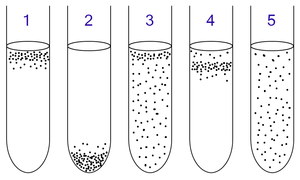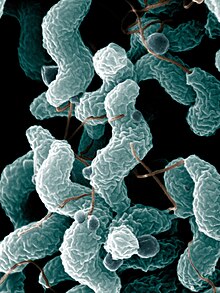
1中培養的是專性需氧微生物。因爲它們不能進行發酵及無氧呼吸,所以它們浮在了氧含量最高的上層。
2中培養的是專性厭氧微生物。因爲它們體內因無過氧化氫酶等物質無法在有氧條件下存活,故浮在氧含量最低的下層。
3中培養的是兼性厭氧菌。它們既可以在有氧條件下也能夠在無氧條件下生存,所以它們分佈在試管培養基上的各處。但因爲有氧呼吸較無氧呼吸能產生更多的ATP(三磷酸腺苷),故更多的菌體分佈在上層。
4中培養的是微需氧微生物。它們不能進行發酵及無氧呼吸,也不能在高氧濃度環境中存活,故它們浮在試管中上層。
5中培養的是耐氧厭氧生物。這種細菌不能進行有氧呼吸,但卻可以在高氧濃度環境下存活,所以它們均勻地分佈在試管培養基上各處。
微需氧微生物(Microaerophile)是一類必須要靠氧氣才能生存的微生物。但是,它們能生存環境中的氧氣含量低於現在大氣中的氧含量(大氣中氧含量通常爲20%-21%,而這種生物生存環境的氧含量一般爲 2-10%)[1][2]。許多微需氧型微生物同樣也是需要高濃度二氧化碳(CO2)的嗜二氧化碳生物(比如說屬微需氧型的弯曲菌属就生活在二氧化碳濃度爲10%的環境中)[3]。
培養
微需氧微生物可培養在蠟燭罐中。所謂蠟燭罐是一個密封容器。在關上其密封蓋前,要先在裏面放上一支點燃的蠟燭。這支燃燒的蠟燭在熄滅前會消耗罐內的氧氣,並且生成二氧化碳,從而創造出適合微需氧型微生物生存的高二氧化碳、低氧氣環境。[4]創建一個微需氧環境的方法還有使用氣體發生包、氣體交換。[3]
例子

參見
參考
- ^ Hogg, S. Essential Microbiology 1st. Wiley. 2005: 91–107. ISBN 0-471-49754-1.
- ^ Prescott LM, Harley JP, Klein DA. Microbiology 3rd. Wm. C. Brown Publishers. 1996: 130–131. ISBN 0-697-29390-4.
- ^ 3.0 3.1 3.2 Brooks GF, Carroll KC, Butel JS, Morse SA. Jawetz, Melnick & Adelberg's Medical Microbiology 24th. McGraw Hill. 2007: 273–275. ISBN 0-07-128735-3.
- ^ Salim SM, Mandal J, Parija SC. Isolation of Campylobacter from human stool samples. Indian J Med Microbiol. March 2014, 32 (1): 35–38. PMID 24399385. doi:10.4103/0255-0857.124294.
- ^ Fernie DS, Park RW. The isolation and nature of campylobacters (microaerophilic vibrios) from laboratory and wild rodents. J. Med. Microbiol. August 1977, 10 (3): 325–9. PMID 330861. doi:10.1099/00222615-10-3-325.
- ^ Cover TL. Perspectives on methodology for in vitro culture of Helicobacter pylori. Methods Mol Biol. 2012, 921: 11–15. PMID 23015486. doi:10.1007/978-1-62703-005-2_3.








